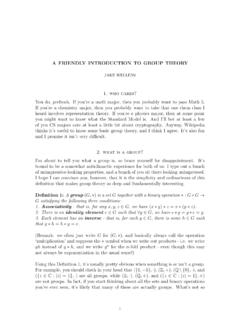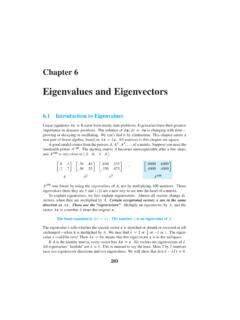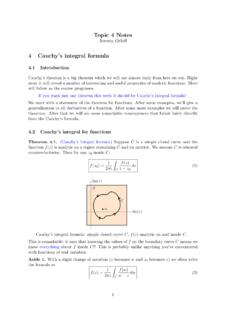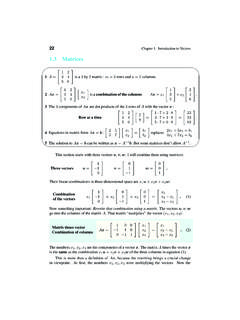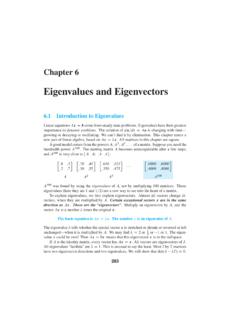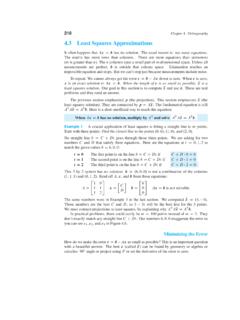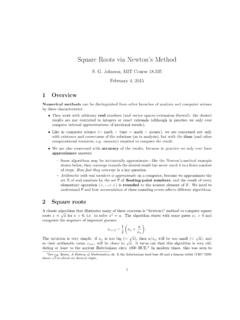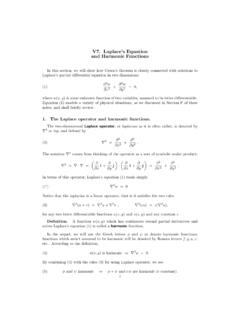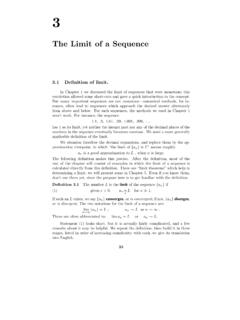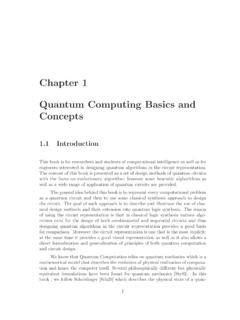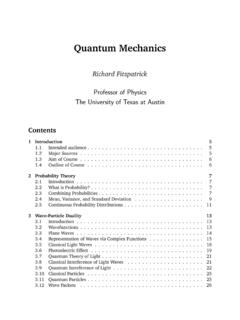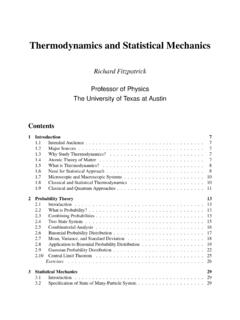Transcription of Introduction to representation theory
1 Introduction to representation theoryPavel Etingof, Oleg Golberg, Sebastian Hensel,Tiankai Liu, Alex Schwendner, Dmitry Vaintrob, and Elena YudovinaJanuary 10, 2011 Contents1 Basic notions of representation What is representation theory ? .. Algebras .. Representations .. Ideals .. Quotients .. Algebras defined by generators and relations .. Examples of algebras .. Quivers .. Lie algebras .. Tensor products .. The tensor algebra .. Hilbert s third problem .. Tensor products and duals of representations of Lie algebras .. Representations ofsl(2) .. Problems on Lie algebras .. 212 General results of representation Subrepresentations in semisimple representations.
2 The density theorem .. Representations of direct sums of matrix algebras .. Filtrations .. Finite dimensional algebras .. Characters of representations .. The Jordan-H older theorem .. The Krull-Schmidt theorem .. Problems .. Representations of tensor products .. 313 Representations of finite groups: basic Maschke s Theorem .. Characters .. Examples .. Duals and tensor products of representations .. Orthogonality of characters .. Unitary representations. Another proof of Maschke s theorem for complex represen-tations .. Orthogonality of matrix elements .. Character tables, examples.
3 Computing tensor product multiplicities using character tables .. Problems .. 434 Representations of finite groups: further Frobenius-Schur indicator .. Frobenius determinant .. Algebraic numbers and algebraic integers .. Frobenius divisibility .. Burnside s Theorem .. Representations of products .. Virtual representations .. Induced Representations .. The Mackey formula .. Frobenius reciprocity .. Examples .. Representations ofSn.. Proof of Theorem .. Induced representations forSn.. The Frobenius character formula .. Problems .. The hook length formula .. Schur-Weyl duality forgl(V).
4 Schur-Weyl duality forGL(V) .. Schur polynomials .. The characters ofL .. Polynomial representations ofGL(V) .. Problems .. Representations ofGL2(Fq) .. Conjugacy classes inGL2(Fq) .. 1-dimensional representations .. Principal series representations .. Complementary series representations .. Artin s theorem .. Representations of semidirect products .. 765 Quiver Problems .. Indecomposable representations of the quiversA1,A2,A3.. Indecomposable representations of the quiverD4.. Roots .. Gabriel s theorem .. Reflection Functors .. Coxeter elements .. Proof of Gabriel s theorem .. Problems.
5 966 Introduction to The definition of a category .. Functors .. Morphisms of functors .. Equivalence of categories .. Representable functors .. Adjoint functors .. Abelian categories .. Exact functors .. 1047 Structure of finite dimensional Projective modules .. Lifting of idempotents .. Projective covers .. 107 INTRODUCTIONVery roughly speaking, representation theory studies symmetry in linear spaces. It is a beautifulmathematical subject which has many applications, rangingfrom number theory and combinatoricsto geometry, probability theory , quantum mechanics and quantum field theory was born in 1896 in the work of the German mathematician F.
6 This work was triggered by a letter to Frobenius by R. Dedekind. In this letter Dedekindmade the following observation: take the multiplication table of a finite groupGand turn it into amatrixXGby replacing every entrygof this table by a variablexg. Then the determinant ofXGfactors into a product of irreducible polynomials in{xg}, each of which occurs with multiplicityequal to its degree. Dedekind checked this surprising fact in a few special cases, but could not proveit in general. So he gave this problem to Frobenius. In order to find a solution of this problem(which we will explain below), Frobenius created representation theory of finite present lecture notes arose from a representation theory course given by the first author tothe remaining six authors in March 2004 within the frameworkof the Clay Mathematics InstituteResearch Academy for high school students, and its extendedversion given by the first author toMIT undergraduate math students in the Fall of 2008.
7 The lectures are supplemented by manyproblems and exercises, which contain a lot of additional material; the more difficult exercises areprovided with notes cover a number of standard topics in representation theory of groups, Lie algebras, andquivers. We mostly follow [FH], with the exception of the sections discussing quivers, which follow[BGP]. We also recommend the comprehensive textbook [CR]. The notes should be accessible tostudents with a strong background in linear algebra and a basic knowledge of abstract authors are grateful to the Clay Mathematics Institute for hostingthe first version of this course. The first author is very indebted to Victor Ostrik for helping himprepare this course, and thanks Josh Nichols-Barrer and Thomas Lam for helping run the coursein 2004 and for useful comments.
8 He is also very grateful to Darij Grinberg for very careful readingof the text, for many useful comments and corrections, and for suggesting the Exercises in , , , , , and more on the history of representation theory , see [Cu].41 Basic notions of representation What is representation theory ?In technical terms, representation theory studies representations of associative algebras. Its generalcontent can be very briefly summarized as algebraover a fieldkis a vector spaceAoverkequipped with an associativebilinear multiplicationa,b7 ab,a,b A. We will always consider associative algebras with unit, , with an element 1 such that 1 a=a 1 =afor alla A.
9 A basic example of an associativealgebra is the algebra EndVof linear operators from a vector spaceVto itself. Other importantexamples include algebras defined by generators and relations, such as group algebras and universalenveloping algebras of Lie an associative algebraA(also called a leftA-module) is a vector spaceVequipped with a homomorphism :A EndV, , a linear map preserving the multiplicationand a representationVis a subspaceU Vwhich is invariant under alloperators (a),a A. Also, ifV1,V2are two representations ofAthen thedirect sumV1 V2has an obvious structure of a representation nonzero representationVofAis said to beirreducibleif its only subrepresentations are0 andVitself, andindecomposableif it cannot be written as a direct sum of two nonzerosubrepresentations.
10 Obviously, irreducible implies indecomposable, but not vice problems of representation theory are as follows:1. Classify irreducible representations of a given Classify indecomposable representations Do 1 and 2 restricting to finite dimensional mentioned above, the algebraAis often given to us by generators and relations. Forexample, the universal enveloping algebraUof the Lie algebrasl(2) is generated byh,e,fwithdefining relationshe eh= 2e, hf fh= 2f, ef fe=h.(1)This means that the problem of finding, say,N-dimensional representations ofAreduces to solvinga bunch of nonlinear algebraic equations with respect to a bunch of unknownNbyNmatrices,for example system (1) with respect to unknown matricesh,e, is really striking that such, at first glance hopelessly complicated, systems of equations canin fact be solved completely by methods of representation theory !
